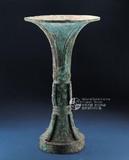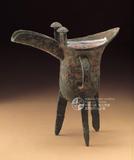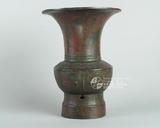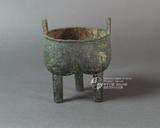TELDAP Collections
| A Story on the Origin of Shang Culture |
|
A Story on the Origin of Shang Culture Taiwan e-Learning and Digital Archives Program (TELDAP): Bridge Project 2009 Story Contest
Honorable Mention by Xu Junqing
The story took place in China from 1562 to 1066 BC during the mysterious Shang Dynasty. The dynasty’s existence was questioned until the discovery of the twelve grand emperor mausoleums in Henan that confirmed its existence and revealed its great prosperity.
The main character of the story is the King in the Shang kingdom. He stands smiling before the newly-built grand mausoleum. Though forgetting just how long the construction has taken, he is sure a lot of manpower and money went into it. He smiles not only at the grandeur of the mausoleum, but also for his absolute power and authority. He remembers how a month earlier some wretched servants protested at being buried alive, but in the end he saw to it that they were entombed in the mausoleum. Of course, this is the whole point of the caste system: position prevails.
What sparkled in the eyes of the King is not a gigantic building like an Egyptian pyramid. The Shang mausoleum is constructed underground. Its luxurious interior makes it clear that the King did not build it underground to keep a low profile. It is underground because the Shang people, who grow crops for their livelihood, believe the dead, like growing crops, should be buried underground. As agriculture is manpower intensive, the King wishes to command a large number of people to grow crops for his kingdom after death. Thus, people from the lower castes are sacrificed to accompany the King in death.
The King, almost in a trance, moves slowly as he beholds his splendid achievement. His neck is sore from the weight of many clinking necklaces and bracelets that turn him into a mobile display rack. Despite the discomfort, the King gently restrains the ornaments to stop them from clinking. These ornaments are important to the King. The Shang Dynasty relies on agriculture and venerates nature and natural forces. A year’s toil can be wasted by a drought or a flood which the Shang people have no power to prevent or control. They believe the world is governed by unknown forces, invisible spirits, and gods.
To worship these spirits and gods, and show respect to their ancestors whose farming experience is valued, the Shang people produce special ornaments such as bone ware and jade ware. Without the accumulated knowledge over time, they believe they would repeat mistakes and not make progress. That is why the Shang people hold their ancestors in great respect.
As well as trying to avoid natural disasters passively by worshipping gods and spirits, the Shang people have been actively improving their understanding of the world. Years of observation has shown them that floods and droughts occur in a certain order as do the days of chill and heat. Slowly they devise a farming time-table that accords with the order of nature. This leads to the advancement of astronomy and the calendar system of the Shang Dynasty. By reading the pedigree of the Shang Kings, one can easily discover Celestial Stems in their names. Examples include the notorious tyrant King Zhou, named Di Xin, King Pan Geng who moved the capital, and others such as Di Yi and Tai Ding. Agriculture plays a big part in the Shang Dynasty.
After touring his mausoleum, the King decides to return and amuse himself with his collection of bronze ware. His favorite bronze wares are the cauldrons (dings) carved with bull and deer designs. The carvings are not faithful depictions of the animals but abstract pictures that make the cauldrons somewhat mystical and awe-inspiring. The bull on the bull cauldron appears to wear a frightening fiendish mask. The other parts of the cauldron are rigorously filled with irregular decorative patterns. These artifacts are indispensable in that they lend mystery to the worship ceremonies and made people stand in awe of the gods, spirits, and the royal family. Holding the jade necklace in his hands, the King prays that the Dynasty and his power will be everlasting.
As it turned out, the Shang Dynasty did not stand the test of time but the mysterious Shang culture is no less captivating. It speaks out for China’s long history and demonstrates that the wisdom of the Chinese people is second to none.
Digital Archives of Historical Artifacts, Institute of History and Philology, Academia Sinica
Category I: Archaeological discoveries, photos, records and files
Items of the Collection: A Story on the Origin of Shang Culture
 Bronze Goblet
‧ Subject and Keywords: Bronze Ware and Metal Ware
‧ Description: Utensil Form: Goblet
‧ Data Identifier: Registration No. 6884
 Bronze Goblet
‧ Subject and Keywords: Bronze Ware and Metal Ware
‧ Description: Utensil Form: Goblet
‧ Data Identifier: Registration No. 6885
 Bronze Tripod Stemware
‧ Subject and Keywords: Bronze Ware and Metal Ware
‧ Description: Utensil Form: Tripod Stemware
‧ Data Identifier: Registration No. 6886
 Bronze Gong
‧ Subject and Keywords: Bronze Ware and Metal Ware
‧ Description: Utensil Form: Wine Jar
‧ Data Identifier: Registration No. 6910
 Bronze Two-handled Round Vessel
‧ Subject and Keywords: Bronze Ware and Metal Ware
‧ Description: Utensil Form: Two-handled Round Vessel
‧ Data Identifier: Registration No. 10804
 Three-legged Cauldron
‧ Subject and Keywords: Bronze Ware and Metal Ware
‧ Description: Utensil Form: Three-legged Cauldron
‧ Data Identifier: Registration No. 30158
|












